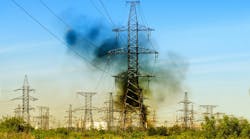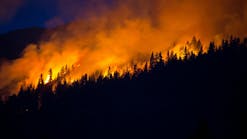Searing temperatures are testing the electric grid like never before. Extreme-weather events, such as severe droughts fueled by climate change, have created ideal conditions for wildfires in the Western US.
According to the National Interagency Fire Center’s Drought Monitor, as of July 8th, 2022, 56 “large” wildfires are currently affecting some 2.7 million acres in California, Arizona, and New Mexico. The agency estimates that more than 1,520,000 people live within 10 miles of an active, large wildfire.
Rising temperatures, drought conditions, and dry vegetation are all major contributors to wildfires with possible ignition sources including lightning strikes, unattended campfires, and other man-made causes. In fact, 90% of wildfires are caused by human impact. Unfortunately, one of the leading contributors to the problem is electric transmission and distribution equipment, which are responsible for close to 150,000 acres lost to wildfires, twice as much as any other cause. Even more jarring is that two of the three most devastating wildfires in American history were caused by power lines.
How does this happen?
Downed lines
When power lines fall — due to high winds or other threats, they’re usually still energized and will discharge their energy into the ground via an arcing until the utility can identify the fault and turn off the circuit, stopping the flow of electricity. If the ground that the broken power line is in contact with happens to be dry vegetation, which is becoming more and more common due to climate change and extreme droughts, (or, more recently, “mega droughts,”) it can catch on fire, starting a blaze.
Vegetation Contact
Trees and other sources of vegetation pose a variety of threats to power lines. A falling tree can tear a line down and cause a downed line. Even if a power line doesn’t fall to the ground, if a tree branch stays in constant contact with the conductor, it can ignite and can cause a fire. A pretty stark reminder of this threat can be seen here.
Conductor Slap
Many types of overhead line conductors, the wire carrying the energy, are not coated with any type of dielectric material which would prevent the energy from escaping when in contact with a nearby object. In high-wind events, these conductors, which typically come in sets of 3, can experience significant side-to-side motion, called blowout. When this motion becomes asynchronous, meaning the conductors are swinging toward one another there is a chance they can touch, an event called “conductor slap.” When this happens, a phase-to-phase arc takes place which can drop molten metal to the ground catching the vegetation on fire. This was sadly the cause of the ignition of the 2017 Cascade Fire in California which resulted in the loss of four lives.
Many of these tragedies could likely have been avoided by using best practices in fire control, and vegetation management, as well as modernizing aging grid facilities and utilizing the latest technologies available. Indeed, investments in power infrastructure were one of the centerpieces of President Biden’s US$ 550 billion infrastructure plan, which included US$ 73 billion for investment in power infrastructure to make the US infrastructure resilient against the impacts of climate change, cyber and extreme weather events.
The need to expand and modernize transmission assets has never been greater. A recent Princeton study showed that grid capacity will need to double by 2035 for a zero net carbon grid and triple by 2050 to support the electrification of transportation, buildings, and industry. It is not just a larger grid that is required, but one that can withstand increasingly extreme weather events. Wildfires in the west have cost the U.S., billions in damages while highlighting the fragility of our aging infrastructure.
There are steps that utilities can take toward becoming more resilient, including installing grid-tech sensors to obtain accurate information on the conditions of their power lines. Further, sophisticated forecasting can help utilities understand what their power needs will be down the line. Currently, 99.9% of power lines aren’t even monitored. Which, given the stakes in a world staring down climate change, is unthinkable.
LineVision has a suite of tools to inform utilities about the health and the sag of their conductors. Working in concert to provide a consistent flow of vital data and information, LineVision’s technologies provide a data-driven and actionable level of situational awareness and predictive analysis — helping utilities and other grid participants anticipate potential failures, overcome capacity limitations, identify the need for proactive replacement, and provide overall better and safer performance.
At the same time, LineVision works in concert with existing data gathering, monitoring, and evaluation technologies such as drones, helicopter inspections, and vegetation management practices. Equipping transmission lines with monitoring needed to potentially prevent fires would cost a tiny fraction compared to the hundreds of millions in damages and economic loss caused by wildfires in California alone. In fact, equipping power lines with LineVision’s monitoring systems would cost a fraction of the damage caused by even a single fire.


